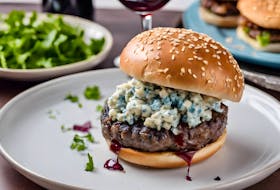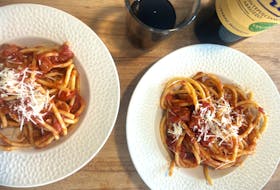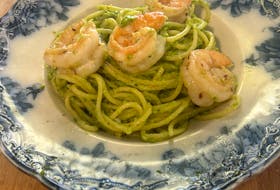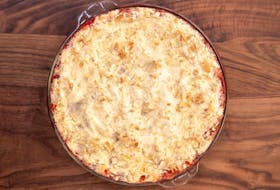Raw, perhaps with a little mignonette, slurping back briny oysters on the half shell is a classic French way to ring in the new year. For Victoria-based photographer Rebecca Wellman, “there will be oysters for sure” on New Year’s Eve, preferably from Quadra Island.
For “the perfect lineup,” Wellman and Bisous & Brioche co-author Laura Bradbury recommend starting with their oysters on the shell with green apple mignonette, followed by beef bourguignon and poire belle-Hélène — with a cheese platter in-between the main course and dessert.
Under normal circumstances, Bradbury divides her time between Victoria and Villers-la-Faye in the Beaune district of France. Inspired by her Grape Series memoirs, Bisous & Brioche gives readers a glimpse into her Burgundian kitchen. In the name of research, Bradbury and Wellman travelled to the fabled wine region last fall — an experience they’re even more grateful to have shared given current restrictions.
“It feels so carefree to look back on that trip,” says Bradbury. “Wine tasting and biking in the vineyards, going to markets — it was just that moment of innocence before the pandemic started.”
For Wellman, being able to see the places she had read about in Bradbury’s memoirs — the village where she met her husband, Franck, and the three vacation properties they renovated — “was the cherry on top of the whole thing. It was just so magical.”
Bradbury began her writing career in 2012, immediately after being diagnosed with primary sclerosing cholangitis (PSC), a degenerative disease of the bile ducts. Her memoirs provided a lifeline as she waited for a liver transplant — a way for her to have a foot in France when she was too ill to travel.
Her friend Nyssa donated the right lobe of her liver in 2017 for Bradbury’s life-saving transplant. Nine books in, she still feels the same drive to write as she did when awaiting the operation.
“For 10 years I started eight or nine books, and didn’t finish any of them because I was so worried about judgement, criticism and failure. Then, being diagnosed with a terminal illness — all of a sudden those fears just vanished. The one thing I was scared of was dying with my stories still inside me. And so for me, it was a way to assert the fact that I was still alive,” says Bradbury. “Creating anything, it doesn’t matter what it is, is one of the most life-affirming things you can do.”
Starting with her accumulation of French recipes — passed down through Franck’s family or shared by close friends — the authors added favourites Bradbury has eaten over the years in France, as well as originals Wellman created specifically for the book, which Bradbury has since woven into her repertoire.
Some, such as a Franco-Canadian spin on Burgundian glazed carrots — which combines Dijon mustard and maple syrup — and salmon rillettes, swapping the customary duck, rabbit or pork, have a West Coast touch.
By her own admission, Bradbury is “certainly not a naturally born cook” — her mother banned her from the kitchen as a teenager after an incendiary baking session — and the authors set out to create a book that was approachable above all else.
“The genesis of this cookbook is I found some recipes that were really easy to execute that I could handle, but that had results that were really disproportionately awesome,” says Bradbury. “I tried to develop this repertoire of things that are no-fail — like my chocolate cake, tomato tart, a good quiche — and it helped give me confidence in the kitchen. So I’m hoping that it will do that for other people as well.”
The author of First, We Brunch , Wellman specializes in recipe development as well as food styling and photography. As a cook, she prefers challenging, multi-day recipes, but for Bisous & Brioche it was all about paring back — fewer ingredients and less-laborious steps. Instead of making duck confit for their cassoulet, for example, she incorporates a shortcut: chicken cooked in duck fat.
“It was a good challenge,” says Wellman. “It was fun.”
“France has their culinary tradition and … they’re kind of rigid. But then there’s Burgundy that’s even more rigid,” adds Bradbury, laughing. “It’s very grounded in the terroir. As much as the wine is, the food there is as well, which is one of the reasons why they don’t like straying very far … But some of the recipes did stray a little bit, in the best possible way.”
Just as writing her Grape Series memoirs provided an escape for Bradbury, Bisous & Brioche has become a similar salvation during the pandemic — one that the authors hope others will share in.
Creativity provides an outlet — prompted by books, TV, movies, music, art and cooking, we can roam in our imaginations. While prior to the pandemic, they would have encouraged people to view Bisous & Brioche as travel inspiration, the authors now view it differently.
“I think we’re all seeking things that make us feel engaged in life, whether it’s reading or listening to audiobooks, or cooking or painting. That act of creation is really essential,” says Bradbury.
“Now it’s like, you’re stuck at home, so here’s this book,” adds Wellman. “You can live through this.”
Recipes by Laura Bradbury and Rebecca Wellman, from Bisous & Brioche , copyright © 2020 by Laura Bradbury and Rebecca Wellman. Reprinted with permission of TouchWood Editions.
NEW YEAR’S OYSTERS ON THE SHELL
with Green Apple Mignonette
2 1/2 tbsp (40 mL) finely minced green apple (about 1/4 small apple)
1 small shallot, finely minced (about 1 tbsp)
1/4 tsp (1 mL) granulated sugar
1/4 tsp (1 mL) sea salt
1/2 cup (125 mL) white wine vinegar or champagne vinegar
1 1/2 tsp (7 mL) lemon juice
24 fresh, small, sweet oysters such as Miyagi or Kusshi
Step 1
To make the mignonette, combine the apple, shallot, sugar, salt, vinegar and lemon juice in a small bowl. Cover with plastic wrap and let sit in the fridge for at least 20 minutes and up to 1 hour.
Step 2
Fill a deep, wide platter with crushed ice. Shuck the oysters and place them on the half-shell on the ice. Serve with a dish of mignonette. Add about 1/4 tsp mignonette to each oyster before slurping back with pleasure.
Makes: 24 oysters and 1/2 cup (125 mL) mignonette
BEEF BOURGUIGNON
with Homemade Egg Noodles
6 slices thick-cut bacon, cut into 1/3-inch (8-mm) pieces
3 lb (1.5 kg) stewing beef
2 tbsp (45 mL) vegetable oil
1 large onion, thinly sliced
6 garlic cloves, thinly sliced, lengthwise
1 large carrot, peeled and sliced into coins
2 tbsp (30 mL) all-purpose flour
2 cups (500 mL) deep, dark red wine (Pinot noir if possible! And preferably Burgundy pinot)
2 tbsp (30 mL) tomato paste
2–3 cups (500-750 mL) beef stock
3 bay leaves
5 sprigs fresh thyme
18–24 pearl onions
4 tbsp (60 mL) butter
1 lb (500 g) button mushrooms, stems trimmed (or if you can’t find button, regular sized mushrooms, cut in half)
1/4 cup (50 mL) parsley
1 recipe Homemade Egg Noodles (recipe follows)
Step 1
Heat the oven to 325°F (165°C).
Step 2
Place a large Dutch oven over medium heat and fry the bacon until crisp and brown, about 5 minutes. Using a slotted spoon, transfer the bacon to a large bowl, leaving the fat in the pot.
Step 3
Dry the beef well between paper towels and season it generously on all sides with salt and pepper.
Step 4
Increase the heat to medium-high and brown the beef in the bacon fat on all sides, 3–4 minutes per side. You will need to do this in batches. Add the browned beef to the bowl with the bacon.
Step 5
Add the oil to the pot. Cook the onions until softened, about 5 minutes, scraping up any brown bits from the bottom of the pot. Add the garlic and carrots and cook for another minute.
Step 6
Return the beef and bacon to the pot. Sprinkle in the flour and stir well to coat, cooking for another 2 minutes. Pour in the wine and stir in the tomato paste to combine thoroughly. Add just enough of the stock so that it just barely covers the beef. Throw in the bay leaves and thyme. Cook, uncovered, on the stovetop for 10 minutes, stirring to cook the flour and combine the flavours. Remove from the heat.
Step 7
Place a large piece of parchment paper over the beef, pressing down so it is tight against the beef and comes up the insides of the pot. This seals in the steam and the juices and allows the beef to become beautifully tender and juicy. Cover the pot with its lid and place it in the oven. Let it cook until the beef is fall-apart tender, about 3 hours.
Step 8
At the 2 1/2-hour point, prepare the pearl onions and mushrooms.
Step 9
Fill a large pot with water and bring to a boil over high heat. Throw in the pearl onions and boil for 1 minute. Rinse with cold water and strain. This will make them much easier to peel. Peel them and leave them whole.
Step 10
Place a large sauté pan over medium heat and melt the butter. Add the pearl onions and mushrooms and cook until tender, stirring to keep everything coated with butter, 5–7 minutes.
Step 11
Remove the beef from the oven, stir the onions and mushrooms into the cooked stew, and sprinkle with parsley. Serve over homemade egg noodles.
Serves: 6–8
HOMEMADE EGG NOODLES
2 cups (500 mL) all-purpose flour, plus more for dusting
2 whole large eggs
4 large egg yolks
1 tsp (5 mL) kosher salt, plus more for salting water
Step 1
On a large, clean work surface, pour the flour into a pile, making a well in the centre, about 4 inches (10 cm) wide. Make sure there are walls of flour around the well.
Step 2
Drop the eggs and yolks into the well and whisk gently with a fork. Don’t worry if some of the flour sneaks in at this point. Add the salt.
Step 3
Using a fork, drag the flour gently into the eggs. Continue to do this all around the well until all the flour is incorporated into the eggs and a shaggy, rough dough comes together.
Step 4
Using your hands (and a bench scraper if necessary), gather all the mixture together and start to knead. This will take some time, but just when you think all hope is lost, it will come together.
Step 5
Mix and knead and gather for a good 10–15 minutes until a smooth and very firm dough is formed. If the dough is too wet, add flour 1 tsp at a time; if the dough is too dry, add water with a spray bottle to distribute it evenly. It is difficult to over-knead pasta dough, so don’t be afraid to work hard at this.
Step 6
Once the ball of dough has come together and is nice and smooth, wrap it in plastic wrap and leave on the counter for at least 30 minutes. If you are making the noodles ahead of time, feel free to pop it in the fridge overnight, but ensure you take it out at least 30 minutes before you need to roll it out.
Step 7
A pasta roller is definitely the best bet for rolling out this dough. They are not expensive and are a good little investment if you feel you might do this more than once. If you cannot get your hands on one, you can use a straight-edged rolling pin and place a thin metal ruler on each side of the dough as you roll it thinner to obtain consistency in the thickness of the dough. Either way, you want to get a nice thin dough for these noodles.
Step 8
Line a large sheet pan with parchment paper and dust it lightly with flour.
Step 9
Remove the plastic wrap from the dough and, using a bench scraper, cut the dough into four pieces. Work with one piece at a time and cover the rest of the dough with plastic wrap. Following the manufacturer’s instructions for the pasta roller or by rolling manually, roll the dough to about the thickness of a metal ruler (typically the thinnest or second-thinnest setting on the pasta roller). Start with the biggest setting on the machine, then fold the pasta sheet in half and rerun it through the machine, changing the dial to a thinner setting each time you pass the dough through. Place the finished sheets of pasta on the prepared sheet pan and sprinkle lightly with flour to prevent sticking. Using a knife or pasta roller attachment, cut into strips of your desired width and toss with a bit of flour. Repeat with the remaining pasta dough.
Step 10
Bring a large pot full of well-salted water to a boil over high heat. Add the desired amount of pasta and cook for about 1 minute, taste, and either cook for another 30–60 seconds if needed or drain. Serve with beef bourguignon or your favourite pasta sauce.
Serves: 4–6
POIRE BELLE-HÉLÈNE
1/2 cup (125 mL) granulated sugar
1/4 cup (50 mL) packed brown sugar
1 tsp (5 mL) ground cinnamon
1 tsp (5 mL) vanilla
4 large pears with stems intact
1/2 cup (125 mL) semisweet chocolate chips
1/4 cup (50 mL) whipping cream
Vanilla ice cream to serve
Step 1
Place a large saucepan over medium heat and add 1/2 cup (125 mL) water. Add both sugars, the cinnamon and vanilla. Bring to a boil, then turn down the heat to a simmer and let cook, whisking constantly, until the mixture is brown and slightly thickened, about 5 minutes.
Step 2
Whisk in another 1 cup (250 mL) of water and bring to a simmer.
Step 3
In the meantime, using a small paring knife, carve the core out of the bottom of the pears. Peel the pears, leaving the stems intact. Place the pears in the liquid and simmer, rotating occasionally, until the pears are tender when poked with a knife, 15–20 minutes. Remove from the heat and let the pears cool in the syrup.
Step 4
In a small saucepan over low heat, use a rubber spatula to stir the chocolate chips with the cream until the chocolate melts and is nice and smooth, about 5 minutes.
Step 5
Place a pear on each of four plates. Drizzle chocolate sauce over top and serve with ice cream.
Serves: 4
Copyright Postmedia Network Inc., 2020








